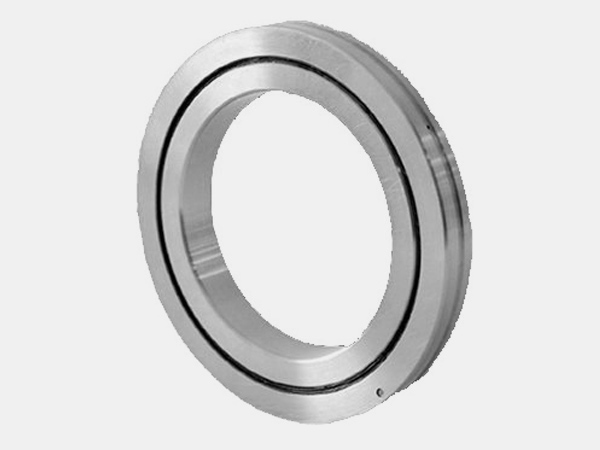Bearings play a crucial role in various mechanical devices. In order to ensure their long-term and effective operation, the materials of bearings are generally selected from a series of bearing steels that are harder and have excellent wear resistance. However, for industrial robots, the commonly used crossed roller bearings require even higher wear resistance and hardenability. Here, the editor of Guoyang Precision Machinery will introduce in detail the materials of crossed roller bearings and other commonly used bearing materials.

I. Materials Commonly Used for General Bearings
The material commonly used for general bearings is GCr15 bearing steel, which is a high-carbon chromium bearing steel with a relatively low alloy content, good performance, and wide application. After quenching and tempering, it has high and uniform hardness, good wear resistance, and high contact fatigue performance. This steel has medium cold working plasticity, general machining performance, poor weldability, high sensitivity to the formation of white spots, and has temper brittleness. Its chemical composition is: C: 0.95-1.05, Mn: 0.25-0.45, Si: 0.15-0.35.
GCr15 bearing steel has good comprehensive properties. After spheroidizing annealing, it has good machining performance. After quenching and tempering, it has high and uniform hardness, high wear resistance and contact fatigue strength, and good hot working performance. It contains fewer alloying elements and is relatively inexpensive. However, it is not suitable for the crossed roller bearings used in robots.
II. Materials of Crossed Roller Bearings
Crossed roller bearings basically use GCr15SiMn bearing steel. Its wear resistance and hardenability are higher than those of GCr15. It has medium cold working plastic deformation, poor weldability, sensitivity to the formation of white spots, and has temper brittleness during heat treatment. It is very suitable for manufacturing the rings of crossed roller bearings with a wall thickness > 12mm and an outer diameter ≥ 250mm, as well as rollers with a diameter > 22mm.
As the main material for crossed roller bearings, GCr15SiMn bearing steel is a high-carbon and high-chromium bearing steel. It has higher wear resistance and hardenability than GCr15 steel. Its critical quenching diameter in oil is 90-110mm (with a martensite volume fraction of 50%). After quenching in oil at 840°C and tempering at 350°C, and then undergoing optical quenching, the surface hardness can reach as high as 1096HV, and the depth of the hardened layer can reach 1mm. In response to the deficiencies of the heat treatment process for forming rollers, pre-cooling and temperature reduction at the thin edge are adopted to cause non-martensitic transformation, generating troostite or sorbite, enhancing toughness, reducing stress, and then quenching the whole to meet the process requirements. Performing sub-zero treatment can improve the dimensional stability of crossed roller bearings, or performing martensitic graded quenching to stabilize the retained austenite and obtain high dimensional stability and higher toughness. It is generally not recommended to forge GCr15SiMn bearing steel, and it is usually used after quenching and low-temperature tempering.
III. Other Bearing Materials
In addition to GCr15 bearing steel and GCr15SiMn bearing steel used for crossed roller bearings, GCr6 bearing steel and GCr9 bearing steel are also frequently used in the production of bearings. Among them, GCr6 bearing steel is more inclined to be used for manufacturing measuring tools, while GCr9 bearing steel is mainly used for manufacturing steel balls and rollers.
The hardenability, hardness, and wear resistance of GCr6 bearing steel are higher than those of carbon tool steel, and the dimensional change during heat treatment is not significant. It is widely used as measuring tools, such as templates, gauge blocks, gauge sleeves, gauges, gauge blocks, ring gauges, thread plug gauges, and gauge posts, etc. It can also be used to manufacture cold working dies such as wire drawing dies and cold heading dies, as well as low-speed cutting tools for cutting materials that are not too hard.
The wear resistance and hardenability of GCr9 bearing steel are higher than those of GCr6 bearing steel. Its machining performance is acceptable, its cold strain plasticity is medium, its weldability is poor, it is also relatively sensitive to the formation of white spots, and there is a tendency of temper brittleness during heat treatment. It is mainly used for manufacturing steel balls with a diameter of 13.5-25.4mm, tapered rollers with a diameter of 10.3-18.5mm, cylindrical rollers with a diameter of 9.4-17.2mm, and spherical rollers with a diameter of 9.2-17.1mm.
The above is an introduction to the commonly used bearing materials provided by the editor of Ouna. It can be clearly seen that the materials of crossed roller bearings have higher wear resistance and hardenability than the steels used for general bearings. Moreover, through special processing methods, their dimensional stability can be more effectively ensured, which is why they are widely used in industrial robots.